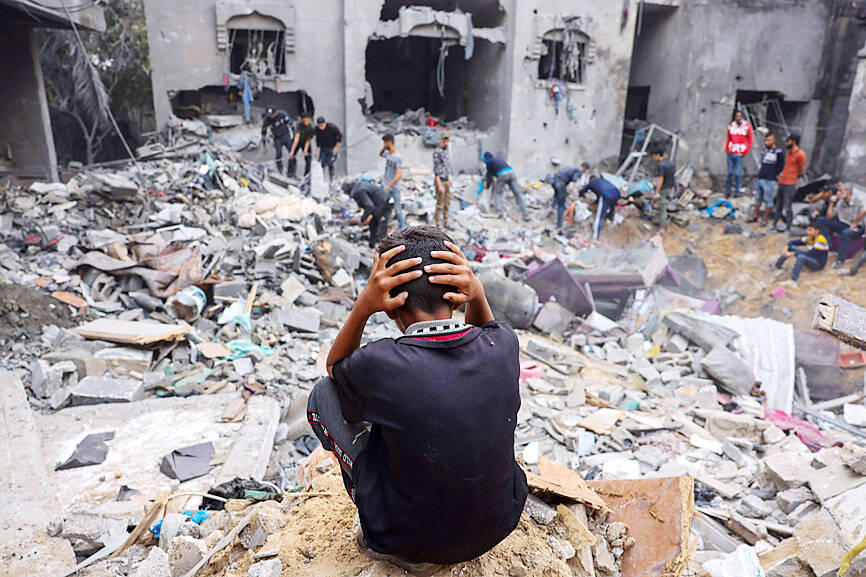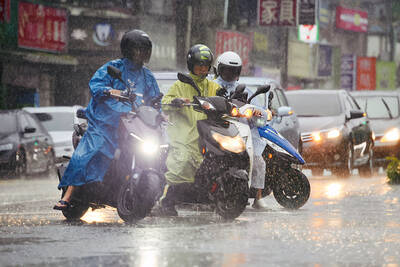Israeli strikes pounded Gaza City overnight and into yesterday as ground forces battled Hamas militants near the territory’s largest hospital, where health officials say thousands of medics, patients and displaced people are trapped with no electricity and dwindling supplies.
In a televised address on Saturday, Israeli Prime Minister Benjamin Netanyahu rejected growing international calls for a ceasefire unless it includes the release of all the nearly 240 hostages captured by Hamas in the Oct. 7 rampage that triggered the war, saying Israel was bringing its “full force” to the battle.
In Gaza City, residents reported heavy airstrikes and shelling overnight, including in the area around al-Shifa Hospital. Israel, without providing evidence, has accused Hamas of concealing a command post inside and under the hospital compound, allegations denied by Hamas and hospital staff.

Photo: AFP
“We spent the night in panic waiting for their arrival,” said Ahmed al-Boursh, a resident taking shelter in the hospital. “They are outside, not far from the gates.”
Munir al-Boursh, the undersecretary of Gazas’ health ministry, said Israeli snipers have deployed around al-Shifa, firing at any movement inside the compound.
He said airstrikes had destroyed homes next to the hospital, killing three people, including a doctor.
“There are wounded in the house, and we can’t reach them,” he told al-Jazeera television in an interview from the hospital. “We can’t stick our heads out of the window.”
Israel’s military said there was a safe corridor for civilians to evacuate from al-Shifa to southern Gaza, but people sheltering in the hospital said they were afraid to go outside.
The military said troops would assist in moving babies yesterday.
It was not possible to independently ascertain the situation.
Thousands have fled al-Shifa and other hospitals, but physicians have said it is impossible for everyone to get out.
The Palestinian Red Crescent rescue service said another Gaza City hospital, al-Quds, is “no longer operational” because it has run out of fuel.
Nebal Farsakh, a spokesperson for the Red Crecent, said 6,000 people, including displaced families, patients, and medical staff, remained trapped in the hospital.
On Saturday, Netanyahu began to outline Israel’s postwar plans for Gaza.
Netanyahu said Gaza would be demilitarized and that Israel would retain the ability to enter Gaza freely to hunt down militants.
He also rejected the idea that the Palestinian Authority, which currently administers parts of the Israeli-occupied West Bank, would at some stage control Gaza.
Meanwhile, Arab and Muslim leaders on Saturday condemned Israeli forces’ “barbaric” actions in Gaza, but declined to approve punitive economic and political steps against the country over its war against Hamas.
The outcome of a joint summit of the Arab League and the Organisation of Islamic Cooperation in Riyadh highlighted regional divisions over how to respond to the war even as fears mount that it could draw in other countries.
The final declaration on Saturday rejected Israeli claims that it is acting in “self-defence” and demanded that the UN Security Council adopt “a decisive and binding resolution” to halt Israel’s “aggression.”
It also called for an end to weapons sales to Israel and dismissed any future political resolution to the conflict that would keep Gaza separate from the Israeli-occupied West Bank.
Additional reporting by AFP

The combined effect of the monsoon, the outer rim of Typhoon Fengshen and a low-pressure system is expected to bring significant rainfall this week to various parts of the nation, the Central Weather Administration (CWA) said. The heaviest rain is expected to occur today and tomorrow, with torrential rain expected in Keelung’s north coast, Yilan and the mountainous regions of Taipei and New Taipei City, the CWA said. Rivers could rise rapidly, and residents should stay away from riverbanks and avoid going to the mountains or engaging in water activities, it said. Scattered showers are expected today in central and

COOPERATION: Taiwan is aligning closely with US strategic objectives on various matters, including China’s rare earths restrictions, the Ministry of Foreign Affairs said Taiwan could deal with China’s tightened export controls on rare earth metals by turning to “urban mining,” a researcher said yesterday. Rare earth metals, which are used in semiconductors and other electronic components, could be recovered from industrial or electronic waste to reduce reliance on imports, National Cheng Kung University Department of Resources Engineering professor Lee Cheng-han (李政翰) said. Despite their name, rare earth elements are not actually rare — their abundance in the Earth’s crust is relatively high, but they are dispersed, making extraction and refining energy-intensive and environmentally damaging, he said, adding that many countries have opted to

People can preregister to receive their NT$10,000 (US$325) cash distributed from the central government on Nov. 5 after President William Lai (賴清德) yesterday signed the Special Budget for Strengthening Economic, Social and National Security Resilience, the Executive Yuan told a news conference last night. The special budget, passed by the Legislative Yuan on Friday last week with a cash handout budget of NT$236 billion, was officially submitted to the Executive Yuan and the Presidential Office yesterday afternoon. People can register through the official Web site at https://10000.gov.tw to have the funds deposited into their bank accounts, withdraw the funds at automated teller

CONCESSION: A Shin Kong official said that the firm was ‘willing to contribute’ to the nation, as the move would enable Nvidia Crop to build its headquarters in Taiwan Shin Kong Life Insurance Co (新光人壽) yesterday said it would relinquish land-use rights, or known as surface rights, for two plots in Taipei’s Beitou District (北投), paving the way for Nvidia Corp to expand its office footprint in Taiwan. The insurer said it made the decision “in the interest of the nation’s greater good” and would not seek compensation from taxpayers for potential future losses, calling the move a gesture to resolve a months-long impasse among the insurer, the Taipei City Government and the US chip giant. “The decision was made on the condition that the Taipei City Government reimburses the related